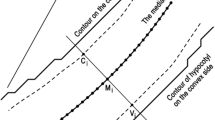Abstract
Etiolated seedlings of Arabidopsis thaliana nutated under conditions of physiological darkness while about ten percent of monitored individuals exhibited regular elliptical nutation, circumnutation. Pre-irradiation with red light prevented occurrence of circumnutation without having an effect on the average rate of the nutational movement. Phototropic response of seedlings to unilateral blue light appeared to be superimposed over nutation. Throughout gravitropism, some seedlings continued to exhibit nutation suggesting that these two processes are independently controlled. Based on these results, we suggest that nutation in Arabidopsis probably is not controlled by the mechanism predicted by the theory of gravitropic overshoots.
Similar content being viewed by others
References
Andersen H and Johnsson A (1972) Entrainment of geotropic oscillations in hypocotyls of Helianthus annuus-an experimental and theoretical investigation. II. Geotropic movements due to periodically repeated stimulations. Physiol Plant 26: 52–61
Britz SJ and Galston AW (1982) Physiology of movements in stems of seedlings Pisum sativum L. cv. Alaska. Plant Physiol 70: 264–271
Brown AH, Chapman DK, Lewis RF and Venditti AL (1990) Circumnutations of sunflower hypocotyls in satellite orbit. Plant Physiol 94: 233–238
Brown AH (1993) Circumnutations: From Darwin to space flights. Plant Physiol 101: 345–348
Darwin C (1896) The Power of Movements in Plants. New York: D. Appleton and Co.
Galston AW, Tuttle AA and Penny PJ (1964) A kinetic study of growth movements and photomorphogenesis on etiolated pea seedlings. Am J of Botany 51: 853–858
Heathcote DG and Aston TJ (1970) The physiology of plant nutation. J of Exp Bot 21(69): 997–1002
Israelson D and Johnsson A (1967) A theory for circumnutations in Helianthus annuus. Physiol Plant 20: 957–976
Janoudi A and Poff KL (1992) Action spectrum for enhancement of phototropism by Arabidopsis thaliana seedlings. Photochem and Photobiol 56: 655–660
Johnsson A and Israelson D (1969) Phase-shift in geotropical oscillations-a theoretical and experimental study. Physiol Plant 22: 1226–1237
Johnsson A (1979) Circumnutation. In: Haupt W and Feinleib ME (eds) Encyclopedia of plant physiology, N. S., vol. 7: Physiology of movements, pp 627–646. New York: Springer, Berlin, Heidelberg
Orbović V and Poff KL (1991) Kinetics for phototropic curvature by etiolated seedlings of Arabidopsis thaliana. Plant Physiol 97: 1470–1475
Simmons C, Soll D and Migliaccio F (1995) Circumnutation and gravitropism cause root waving in Arabidopsis thaliana. J of Exp Bot 46: 92–99
Volkmann D, Behrens HM and Sievers A (1986) Development and gravity sensing of cress roots under microgravity. Naturwissenschaften 73: 438–441
Author information
Authors and Affiliations
Rights and permissions
About this article
Cite this article
Orbović*, V., Poff, K.L. Interaction of light and gravitropism with nutation of hypocotyls of Arabidopsis thaliana seedlings. Plant Growth Regulation 23, 141–146 (1997). https://doi.org/10.1023/A:1005853128971
Issue Date:
DOI: https://doi.org/10.1023/A:1005853128971




